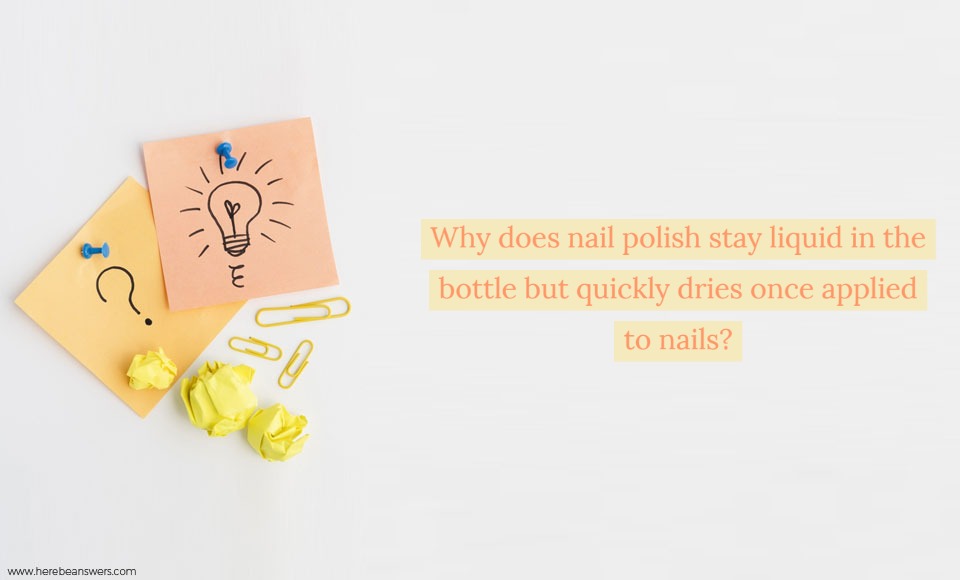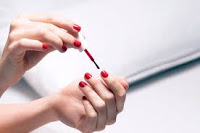Nowadays, nail arts and nail polishes are a fad, especially to women. But to some, to beautify the nails is a part of hygiene and habit. It makes people feel pleasant and relaxed. It is also a way of destressing to some. And for those impatient to wait for their nails to dry, they look for hacks on YouTube and DIY ways to dry their newly polished nails quickly. Some may use a quick-drying solvent, ice-cold water, or let the nail polish naturally dry in the air. But have you wondered why nail polish does not dry inside its bottle but quickly dries when applied on the nails?
Nail polish is a type of lacquer. Lacquer is a liquid either made of shellac dissolved in alcohol or synthetic substances, to form a hard protective coating when dried. Nail polish is used to decorate fingernails and toenails for whoever wants it. It contains some chemicals that make it flexible and resistant to chipping and peeling.
Basic clear nail polish is made of film formers called nitrocellulose, which dissolves in butyl acetate or ethyl acetate. As the acetate solvent evaporates, the nitrocellulose forms a shiny film. But some nail polish, especially the ones used for artsy nail designs, contains an extensive list of ingredients.
(https://www.thoughtco.com/nail-polish-chemistry-603996)
Solvents are the primary components of nail polish. Other ingredients mix and yield a uniform product because of the solvents like ethyl acetate, butyl acetate, and alcohol. Their amount in the nail polish will determine how thick a polish is and how long it will take to dry.
A bottle of nail polish is a mixture of pigments, solvent, and other ingredients. The pigments and other chemicals stick to the surface, and the solvent keeps the paint into its non-sticky fluid form. When you apply the polish to your nail, the pigments and other components stick to your nails, and the solvent just evaporates. The separation of solvent from the other components hardens and solidifies the polish on your nails.
If the nail polish bottle is properly closed, the solvent’s presence maintains the paint and other ingredients in their fluid state. But once the bottle is opened and let the air get in, the solvent will evaporate that will cause the mixture to solidify. It also happens in the paints that we use in our homes and other furniture.
There are other chemicals used in nail polishes, such as:
⦁ Resins. It makes the film stick to the nail bed and adds depth, gloss, and hardness to the nail polish film. The tosylamide-formaldehyde resin is an example of a polymer used as a resin.
⦁ Plasticizers. They are chemicals that help keep nail polish flexible and reduce cracking and chipping. One type of plasticizer widely used is Dibutyl phthalate (DBP). Still, it has been banned in the EU since 2004 due to concerns over the possibility of it interfering with the human hormone system. The presence of plasticizers gives the nail polish its odor. (https://www.compoundchem.com/2017/04/06/nail-polish/)
⦁ Pigments. Women make choices with nail polish, primarily because of this. Pigments are compounds that add color to nail polish. There are organic and inorganic pigments. The inorganic uses a variety of chemicals, including chromium oxide (for green color), iron oxide (red and orange), and ferric ferrocyanide (for blue). These organic pigments are similar to those used in food colorings.
⦁ Pearlescent. Those nail polish that has a shimmery or glittery effect is achieved because of the pearlescent minerals. It can be a titanium dioxide or ground mica mixed in the nail polish, although some use plastic glitters or other additives to produce a special effect. Stearalkonium hectorite is used as a thickener and is added to keep pigments and other additives suspended in the polish.
⦁ Photochromic polishes. Today, there are more fancy types of nail polish that changes in color in response to light. These are photochromic polishes containing light-sensitive compounds, which cause change when exposed to sunlight. The spiropyrans and spirooxazines are examples of these compounds. The change in the absorption of UV light changes the absorption of the compound, resulting in the change of color.
It is fantastic how simple forms of polishing the nails have evolved from the very simple ingredients such as eggs, gelatin, beeswax, and vegetables used in ancient times to these complex compounds that our nail polishes have now. But regardless of how you want your nails to appear, it is still the best option to maintain its health and cleanliness as you use them every day.

